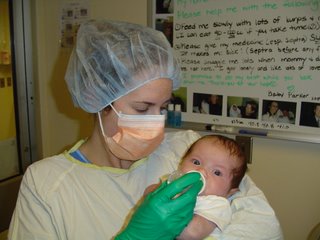 Parker had gone through quite an ordeal Tuesday. You can image how seven pokes and a six hour I.V. in your head could tire you out. That is exactly what it did to Parker. Parker was quite tired today. Of course, that did not stop his mother from working with him on his exercises. The occupational therapist came by today to evaluate Parker's development as she does every week. She again was very impressed with his development as of late. The last time that she was there to see Parker she asked us to work on
Parker had gone through quite an ordeal Tuesday. You can image how seven pokes and a six hour I.V. in your head could tire you out. That is exactly what it did to Parker. Parker was quite tired today. Of course, that did not stop his mother from working with him on his exercises. The occupational therapist came by today to evaluate Parker's development as she does every week. She again was very impressed with his development as of late. The last time that she was there to see Parker she asked us to work on his sitting. As a result, we brought in his swing to help him learn how to sit up. The occupational therapist told us that his sitting is now much improved and suggested that we now bring in his Bumbo Chair to reinforce his sitting. She feels that his neck control and strength are more than ready to handle this advanced task.
his sitting. As a result, we brought in his swing to help him learn how to sit up. The occupational therapist told us that his sitting is now much improved and suggested that we now bring in his Bumbo Chair to reinforce his sitting. She feels that his neck control and strength are more than ready to handle this advanced task.Parker had gained quite a bit of weight after his IGG transfusion on Monday; much more than we had
 anticipated. So when we weighed him tonight, we were not surprised that he dropped much of the weight he gaines from the night before. Parker is now 11 lbs 7 ounces. Although there have been some concern that him gaining weight to quickly, we are very pleased with this trend and are doing what we can to help him reach an appropriate weight for his age and condition.
anticipated. So when we weighed him tonight, we were not surprised that he dropped much of the weight he gaines from the night before. Parker is now 11 lbs 7 ounces. Although there have been some concern that him gaining weight to quickly, we are very pleased with this trend and are doing what we can to help him reach an appropriate weight for his age and condition.The dietician did come by today to take measurements for his length and head circumference. Parker's head circumference is now at the 50th percentile. We are very pleased about this, as I feel that it supports our belief that Parker's neurological development is normal. Parker's weight is just below the 10th pe
 rcentile, and his length is below the third. We are not too surprised about his length as we do know that an ADA deficiency can cause skeletal abnormalities. However, we are pleased that he has grown 1.5 inches in the past month. Parker may be short for a three month old, but that does not mean he will be short the rest of his life. There is no data on how genetic therapy affects the skeletal system long term.
rcentile, and his length is below the third. We are not too surprised about his length as we do know that an ADA deficiency can cause skeletal abnormalities. However, we are pleased that he has grown 1.5 inches in the past month. Parker may be short for a three month old, but that does not mean he will be short the rest of his life. There is no data on how genetic therapy affects the skeletal system long term.
No comments:
Post a Comment